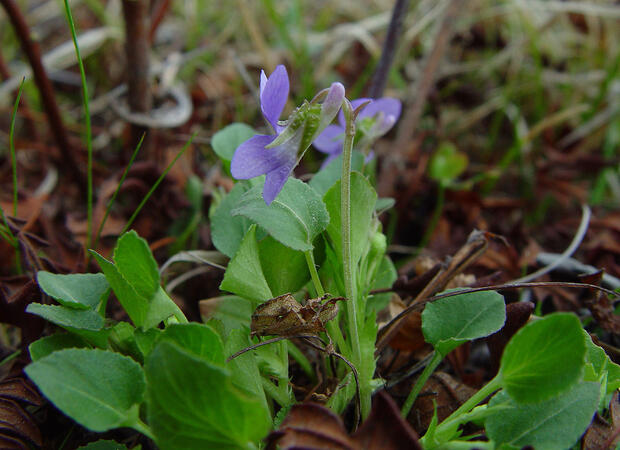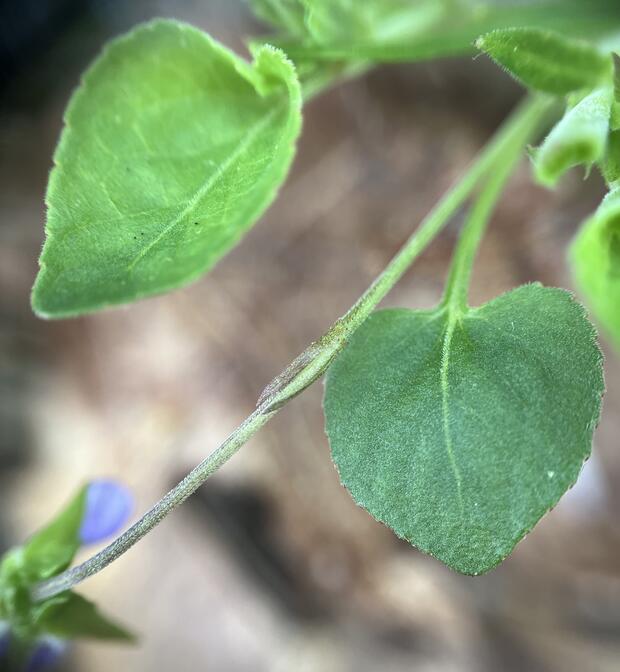- Scientific name: Viola adunca Sm.
- Species of Greatest Conservation Need (MA State Wildlife Action Plan)
- Special Concern (MA Endangered Species Act)
Description
Sand violet (Viola adunca; family Violaceae) is a low-growing perennial herb with dense rosettes of egg-shaped leaves and showy purple-violet flowers borne on leafy stems. It grows in disturbed habitats, usually in full sun, on moist to very dry soils. It competes poorly with other plants and relies on periodic disturbance to remove potential competitors. Violets produce long-lived soil seed banks (ca.100 years in species that have been assessed).
Sand violet produces showy purple-violet flowers about 2 cm (~0.75 in) long at the tops of leafy stems in the early spring. The lateral petals are bearded (i.e., they have tufts of white hairs on their inner faces). The spur (a long, horn-like extension from the base of the flower) is short and blunt. The leaves and stems emerge from the crown of a buried stem and form a low-growing rosette. The leaves are egg-shaped to nearly round in outline, mostly 1-2.5 cm (0.4-1 in) wide and are barely rounded to very slightly heart-shaped at the base. Leaves and flower stalks are covered in short hairs. The stipules (bracts near the leaf bases) have comb-like appendages along their upper edges.
Sand violet is one of only three New England “stemmed violets” (a group of species whose flowers are produced on leafy above-ground stems) with purple-violet flowers. (“Stemless” violets do not produce leafy stems and have flowers on (leafless) stalks that emerge directly from the underground stem.). One of the stemmed species, long-spurred Violet (Viola rostrata), is easily recognized by its pale lilac flowers with a darker center and a 12 mm (0.5 in) spur. It typically occurs in deeper shade. A second species, dog violet (Viola labradorica; syn. V. conspersa), is less distinctive and sometimes grows with sand violet, particularly in moister settings. See the chart below for distinguishing characteristics.
| Character | Sand Violet | Dog Violet | Notes |
|---|---|---|---|
| Leaf shape | Straight-cut to very slightly heart-shaped at base | Heart-shaped at base | Leaf shape varies on a given plant; look at several leaves to see the overall pattern. |
| Hairiness | Leaves and flower stalks covered in very short hairs | Hairless except sometimes slightly hairy on the upper leaf surface | Hairiness can be hard to see without magnification. |
| Seeds | Dark brown to olive-black | Tan to medium- brown | Seeds should be taken from mature capsules |
| Flower spur | Typically 5-7 mm | Typically 2.8- 4.7 mm |
Life cycle and behavior
This is a short-lived perennial species. As noted by Haines on GoBotany, "[v]iolets have two types of flowers and fruits: chasmogamous and cleistogamous." Sand violet has open chasmogamous flowers from mid-April to mid-June. It produces cleistogamous flowers (self-pollinating ones which never open) after the open flowers in late June and early July. Ripe seed pods are present starting late June through mid-August. The pods in violets burst open into 3 sections, scattering seeds a distance from the parent plants.
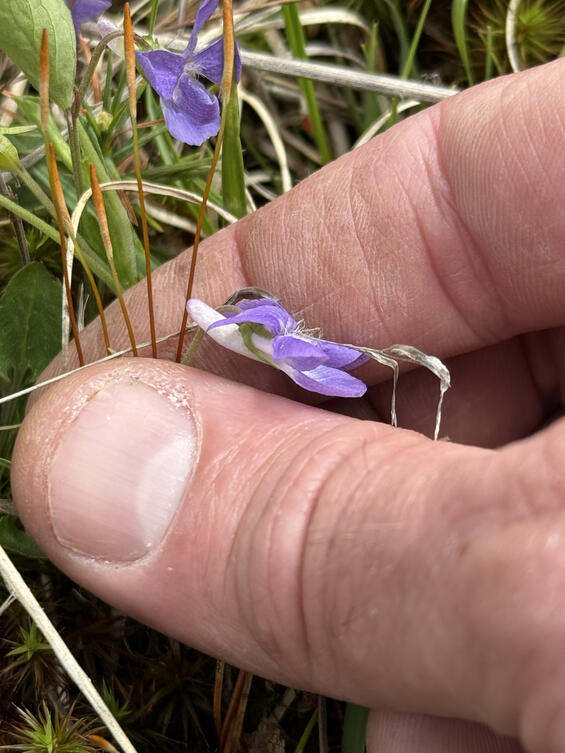
Side view of flower showing spur. Image by Karro Frost.
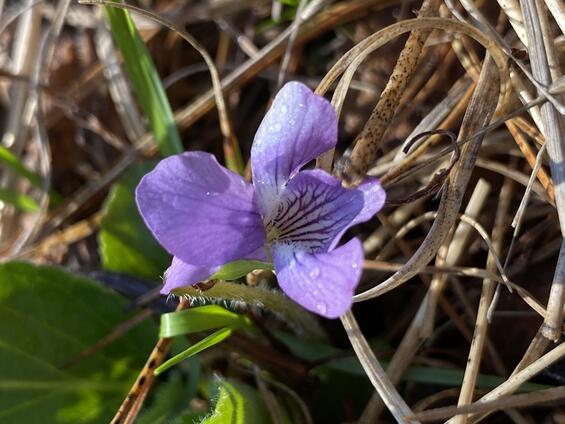
Front view of flowers with hairs on the side. Image by Karro Frost.
Population status
Sand violet is listed under the Massachusetts Endangered Species Act as a species of special concern. All listed species are legally protected from killing, collection, possession, or sale, and from activities that would destroy habitat and thus directly or indirectly cause mortality or disrupt critical behaviors. Sand violets have 22 occurrences that have been documented since 1999 in Essex, Franklin and Worcester Counties. It is known historically from Middlesex County.
Distribution and abundance
Sand violet is broadly distributed from coast-to-coast in North America, primarily at higher latitudes in the eastern half but extends south to Arizona, California and New Mexico in the west. It reaches the southern limit of its eastern North American range in Connecticut, Iowa and Nebraska, and is considered critically imperiled in all 3 states. In New England, it is considered vulnerable in Massachusetts, apparently secure in Vermont, unknown in Rhode Island and has not been assessed in New Hampshire or Maine.
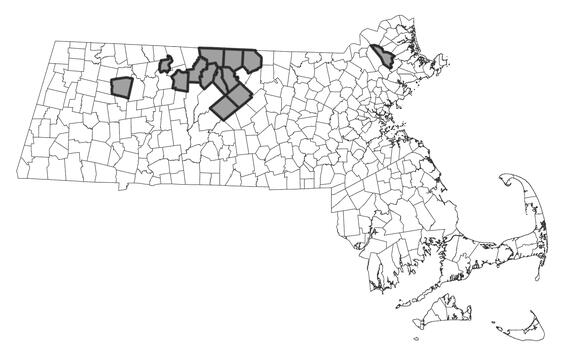
Habitat
Sand violet is a disturbance specialist, growing in areas with a history of vegetation disruption and soil exposure. Typical habitats in Massachusetts include recently used log landings and skid trails, borrow pits, power line rights-of-way, cemeteries, and lawns. It grows on soils ranging from moist, nutrient-rich loams to dry, sterile mineral exposures. It grows best in full sun but may persist (at least for short periods) in partial shade. It is intolerant of competition and is usually found in sparsely vegetated settings with various early-successional, weedy, low-growing species such as wild strawberry (Fragaria virginiana), poverty grass (Danthonia spp.), cinquefoils (Potentilla spp.), arrow-leaf violet (Viola sagittata), and little bluestem (Schizachyrium scoparium).
Healthy habitats are vital for supporting native wildlife and plants. Explore habitats and learn about conservation and restoration in Massachusetts.
Threats
In Massachusetts, sand violet is an obligate disturbance specialist, establishing only in areas that have been subject to intense disturbance sufficient to disrupt existing vegetation, reduce interspecific competition, and leave exposures of bare soil. Violet patches tend to be short-lived and experimental management using burning and mowing have not been effective in promoting long-term persistence.
Conservation
A study on the plants' reliance upon disturbance and which type of disturbance best benefits this species would be helpful. Activities (such as periodic logging) that produce open patches where seeds from nearby plants or buried seed banks may establish new colonies may be an essential component of sand violet management. All active management of rare plant populations (including invasive species removal) is subject to review under the Massachusetts Endangered Species Act and should be planned in close consultation with MassWildlife’s Natural Heritage & Endangered Species Program.
References
Ballard, Harvey E., John T. Kartesz and Misako Nishino. “A taxonomic treatment of the violets (Violaceae) of the A taxonomic treatment of the violets (Violaceae) of the northeastern United States and adjacent Canada” in Journal of the Torrey Botanical Society 150(1): 3–266, 2023.
Gleason, Henry A., and Arthur Cronquist. Manual of Vascular Plants of Northeastern United States and Adjacent Canada, Second Edition. Bronx, NY: The New York Botanical Garden, 1991.
Haines, A. 2011. Flora Novae Angliae – a Manual for the Identification of Native and Naturalized Higher Vascular Plants of New England. New England Wildflower Society, Yale Univ. Press, New Haven, CT.
NatureServe. 2025. NatureServe Network Biodiversity Location Data accessed through NatureServe Explorer [web application]. NatureServe, Arlington, Virginia. Available https://explorer.natureserve.org/. Accessed: 6/3/2025.
POWO (2025). Plants of the World Online. Facilitated by the Royal Botanic Gardens, Kew. Published on the Internet; https://powo.science.kew.org/ Accessed: 6/3/2025.
Contact
| Date published: | May 6, 2025 |
|---|
